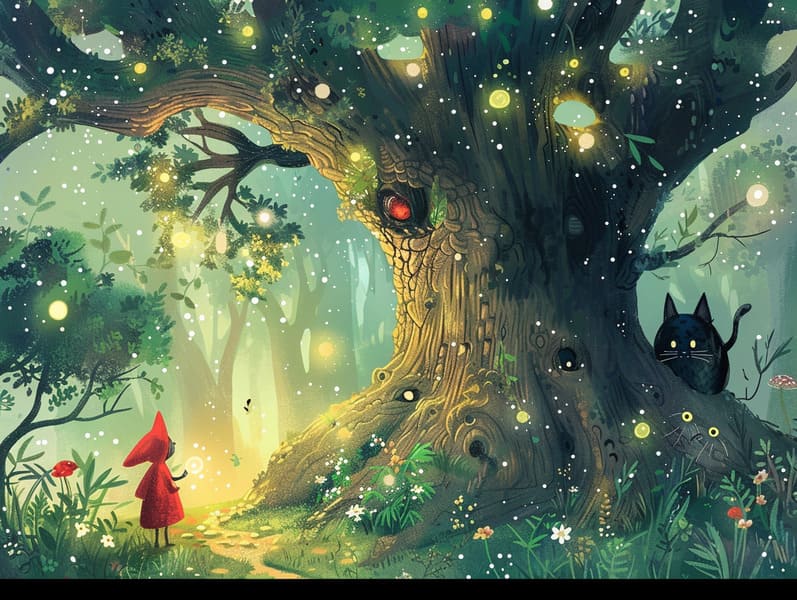
Ancient fairy tales have timeless appeal. These stories have been narrated from one generation to the next ages before they were ever written down. They originated from a variety of backgrounds, including Western traditions. They were initially told among older generations, often carrying themes and messages pertaining to the societal norms and beliefs of the time.
The renowned Brothers Grimm, the two Grimm brothers, were among the first to compile and release many of these beloved fairy tales. Their collection, "Grimm's Fairy Tales," included classics like "Ashenputtel," "The Bread Crumb Trail," and "Snow White," which have since become classics in the world of classic fairy tales. Similarly, Hans Christian Andersen's fantastical narratives, such as "The Sea Maid," and "The Little Duckling," have stolen hearts worldwide, cementing their place in the pantheon of famous fairy tales.
Though they are centuries old, these stories remain as applicable as ever, especially as children's bedtime stories. These enchanting tales are now available in different formats, including vibrantly illustrated books, enchanting animations, and online fairy tales.
Their lasting presence can be attributed to several whimsical characteristics:
Ethical Lessons: Timeless fairy tales often convey important moral lessons. Fairy tales like "The Story of the Boy Who Cried Wolf" teach the importance of being truthful, while "The Tortoise and the Hare" highlight the traits of determination and unassuming nature. These narratives offer kids clear distinctions between truth and falsehood, building their moral compass in a gentle yet meaningful way.
Empathy and Awareness: Traditional fairy tales frequently portray characters facing obstacles and hardships, provoking kids to empathize with their struggles and champion their triumphs. For instance, "The Story of Beauty and the Beast" highlights the merit of seeing beyond looks to realize the inner being of a individual, advancing awareness and perception.
Cultural Perception: Many old fairy tales are steeped in the cultural contexts from which they were born. Engaging with these fairy tales can provide illuminating insights into different traditions, advancing a sense of global understanding and respect.
Creativity and Fantasy: The fantastical elements in fairy tales—magic wands—awaken children’s visions and dreams. These narratives lead readers to enchanted realms, firing up innovative dreams and a sense of mystery that persists a lifetime.
Timeless fairy tales are not only entrancing but also pedagogical. They act as bewitching tools in developing various mind and heart abilities in children. When timeless fairy tales are recited, they foster verbal development by bringing new language and elaborate sentence structures. This practice also nurtures auditory perception and mindfulness, as kids listen intently, ready to see what happens next.
Furthermore, analyzing the themes and here characters of traditional fairy tales can improve thought processes and reasoning skills. Kids are educated to discern patterns, forecast, and realize cause and effect. These contemplations also advance young ones verbalize their thoughts and feelings, cultivating their emotional intelligence.
In today’s digital age, the proliferation of online storybooks has made these narratives more within reach than ever. Web-based platforms and applications supply huge assortments of timeless fairy tales that can be seen or played anytime, anywhere. Fairy tales read aloud are particularly well-liked, making available an fascinating method for little ones to be a part of these bewitching tales. Read-aloud books and read-out-loud stories lead characters and settings to life, often paired with entrancing background sounds and background music that intensify the storytelling experience.
The persistent attraction of classic fairy tales lies in their ability to adjust to modern society while sustaining their main lessons. Contemporary renditions of these stories often spotlight more diverse protagonists and modern settings, making them meaningful to today’s audience. However, the core values of spirit, kindheartedness, and honesty remain unchanged, continuing to resonate with young readers of all ages.
Classic fairy tales also offer a sense of calm and knowability. They disclose a systematic narrative with a obvious beginning, middle, and end, often closing with the culmination of conflicts and the triumph of righteousness over wickedness. This consistency can be calming for young readers, furnishing a sense of consistency in an always shifting world.
Timeless fairy tales continue to enchant and teach new generations, maintaining their attraction and pertinence in modern society. As kids' bedtime tales, they afford a perfect blend of wonder and wisdom, promoting moral values, empathy, and creativity. The proliferation of web-based fairy tales and the favor of fairy tales narrated affirm that these classic tales remain reachable to new generations.
By defending and conveying these tales, we continue to treasure the rich tapestry of narrative artistry and cultural heritage. Whether you are perusing a richly illustrated book, viewing a internet library, or playing an narrated book, the mystique of bedtime fairy tales is always within reach. These stories show us of the lasting influence of narratives and its ability to gather us across centuries and lands.
Even if you are experiencing a richly illustrated book, perusing a electronic collection, or listening via an read-aloud story, the captivation of bedtime fairy tales is always within reach.
These narratives highlight of the lasting power of fairy tales and its ability to connect us across generations and cultures, making a tie that fascinates and enlightens alike.